- Bernard Preston homepage
- Avocado
- Foods for a Healthy Pancreas
Foods for a healthy pancreas
This essay on foods for a healthy pancreas focuses on prevention rather than a cure; mortality is frighteningly high at 35% of those hospitalised. It is the fourth leading cause of cancer deaths in both sexes; rising especially fast in younger women.
The pancreas is an important organ supplying hormones to manage blood glucose and enzymes to enable digestion of food in the small intestine; that latter is the so-called "exocrine function."
There are many causes of pancreatic disease but in one way or another most of them are associated with metabolic syndrome.
- High blood sugar
- Abnormal cholesterol and triglycerides
- Body fat around the waist
- High blood pressure
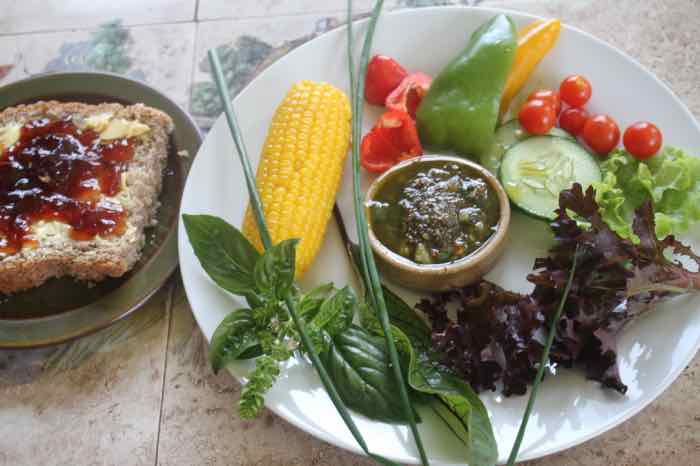 Salads, dips made with olive oil and whole grains
Salads, dips made with olive oil and whole grains1. High blood sugar
Nearly 50% of those enjoying typical supermarket food are suffering from prediabetes; abnormally raised blood glucose. This is the first of the risk factors for pancreatic disease.
2. Abnormal cholesterol and triglycerides
Chronic excessive consumption of refined carbs is thus the second risk factor for pancreatic disease.
With research now showing that consuming foods high in cholesterol hardly affects levels in the plasma, attention is rather being focused on high glucose entering the liver. There it is attached to an amino acid forming a lipoprotein; and then enters the blood stream as LDL and TGs.
Eggs and butter are not the villains of the peace though some would still contest this; but abnormally raised LDL cholesterol is strongly associated with Pancreatic Disease.
Since alcohol is changed in the liver to triglycerides, it too contributes to excessive fat in the blood stream.
Fat is an essential part of the diet; we would die if we did not eat it. But so much food today is ultra-processed in sunflower and soybean oil which, in large quantities upsets the important omega 6 to 3 ratio. That means generalised inflammation of the organs including the pancreas.
3. Visceral fat
"Pancreatic fat is the main driver of the organ's exocrine and endocrine diseases."
- The American Journal of Gastroenterology
Body fat around the waist is deposited deep inside the body.
It is found in and around the organs; especially the heart, liver and pancreas.
When it infiltrates the organs it causes them to malfunction. With Fatty Liver droplets of lipids are deposited within the cells.
But in the pancreas it actually begins to replace the functioning cells of the organ; those that manage blood glucose and digestion.
Fatty atrophy of the pancreas begins to occur.
This disrupts the normal production of the alpha and beta cells of the pancreas that produce gastric enzymes and the hormones which regulate blood glucose; there is a high risk of gall bladder disease and type-2 diabetes.
The acinar cells that produce and store pancreatic enzymes are also affected; poor digestion particularly of dietary fat results. There is malnutrition and the composition of the stool changes.
Visceral fat also acts as an organ producing an array of inflammatory cytokines. This affects the lungs if there is a viral infection such as COVID; breathing becomes difficult. It is also one of the reasons why the obese suffer from far more pain in their muscles and joints; polymyalgia and arthritis.
Is your waist circumference just above the belly button greater than these measurements on full expiration without pulling in your gut?
- 80cm for women
- 94cm for males
4. Hypertension
It is estimated that 70% of primary high blood pressure is caused by obesity[1]. The mechanisms are complex, disturbing the renal hormones and the effect of the aforementioned inflammatory cytokines on the kidneys; and actual physical pressure on the organs by deep adipose tissue.
Ultra-processed food like cereals and commercial bread have no intrinsic flavour; so food companies typically add large amounts of salt.
Gallstones
You have heard it before, probably many times; fat, female and forty. Gallstones are one of the most common causes of acute pancreatitis. To make it worse, surgery increases the risk of injury to the organ.
"The rise in acute pancreatitis may be correlated with increases in metabolic syndrome and obesity; which are associated with gallstone disease[2]."
Fatty Pancreas
"Intrapancreatic fat deposition" as it is known occurs through two mechanisms; lipid droplets in the organ and replacement of the functional cells such as those that produce insulin by "adipocytes."
Adipocytes are lipid droplets; they are the major energy storage sites in the body[4]. However when there are so many of them that they start to replace the cells that produce our hormones like insulin and those that synthesise enzymes for digestion of our food, trouble lies ahead.
Nearly one in five adults living in the UK has Fatty Pancreas; that's extremely high. It is associated with the following statistics.
- A 298% increased risk of acute pancreatitis.
- Increased risk of pancreatic cancer by 98%.
- Diabetes by 34%.
"Illness is the doctor to whom we pay most heed. To kindness and knowledge, we make promise only; pain we obey."
- Marcel Proust.
Acute pancreatitis is associated with severe pain in the centre of the belly; it may refer to the back. Nausea, vomiting and a fever are common.
Lower than normal levels of lipase, the enzyme that digests fat means that rich food may make you nauseous and increase the pain.
Foods for a healthy pancreas
By now it must surely be obvious which foods we should be avoiding for a healthy pancreas; sugar that raises blood glucose, refined grains and deep-fried favourites. And the many dishes to which large amounts of vegetable oil have been added.
Excessive alcohol consumption, more than two shots and especially binge drinking raises triglycerides and stresses both the liver and the pancreas.
Chief of the refined carbs that cause obesity is of course sugar. The Heart Association recommends no more than 6tsp per day. That's probably about right; roughly 10kg per annum.
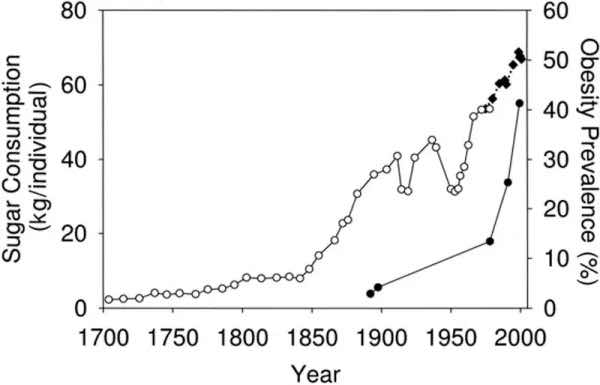 Obesity follows sugar consumption
Obesity follows sugar consumptionThe second of the drivers of obesity and Fatty Pancreas is refined grains; particularly wheat, maize and rice.
Refined grains have no taste; so food manufacturers have to add large amounts of sugar to make them palatable. These are the twin drivers of obesity and pancreatic disease.
To which we should add corn-fed beef, pork and even chicken as causes of Fatty Pancreas. Researchers have been quick to establish that those following the so-called Carnivore Diet are more likely to suffer from cancer of these organs; but often without the obesity associated with refined carbs.
"A diet rich in pork and red meat also increases pancreatic cancer risk by about 50%."
- Cancer Research Center of Hawaii
Two important facts need to be added. There is completely contrary research to this statement; and secondly that this study was done on feedlot pork and beef.
Pasture-fed meat likely is quite different; but so few people are able to acquire it that research with significant numbers becomes well nigh impossible.
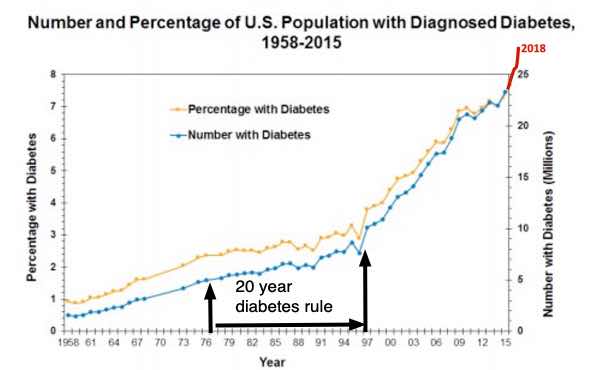 Obesity and diabetes follow refined carb consumption
Obesity and diabetes follow refined carb consumptionThe third driver of obesity and Fatty Pancreas is seed oil. It not only contributes a very large and increasing numbers of calories to the modern "industrial diet" but in excess omega-6 fatty acids are also high inflammatory.
Since refined grains are tasteless, seed oils too are added to improve the taste and mouthfeel of ultra-processed foods; the fat carries the artificial flavour enhancers.
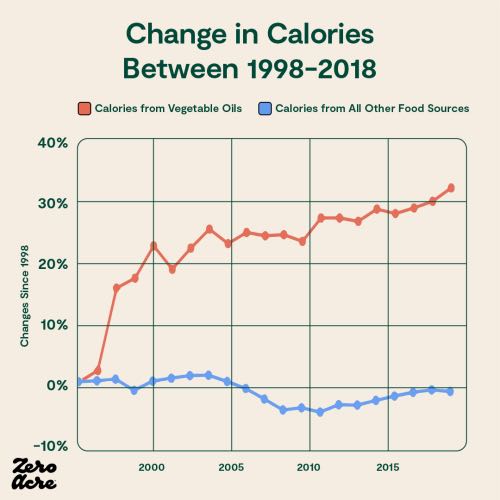 Astonishing rise in seed oils in the last 30 years
Astonishing rise in seed oils in the last 30 yearsRefined and ultra-processed foods
In all three instances healthy foods have been processed to extract sugar, bread flour and seed oils; these are the drivers of obesity and pancreatic disease.
Foods for a healthy pancreas
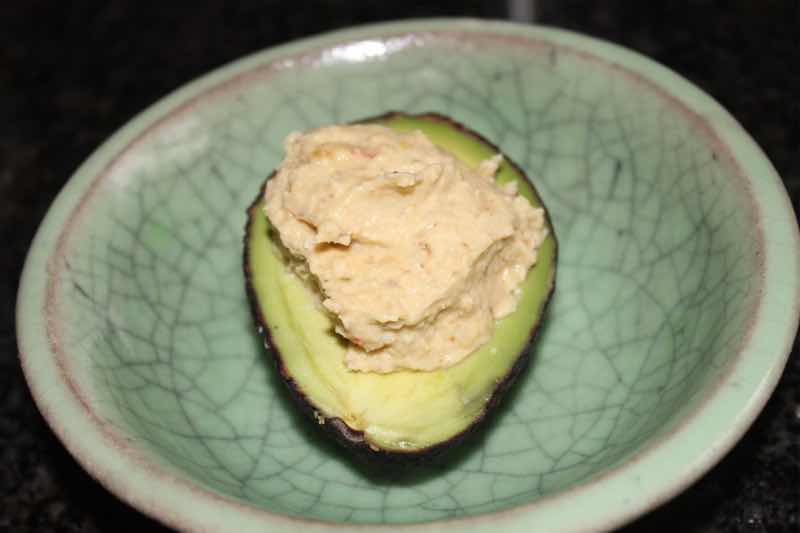 Avocado and hummus made from chickpeas and olive oil
Avocado and hummus made from chickpeas and olive oilThe simple rule when considering the foods for a healthy pancreas is to return to meals that our great-grandparents once ate.
- Pasture-fed meat, whole grains and low sugar; fat from animals, avocados and olives.
- Nuts, whole seeds and oil-rich legumes like soybeans and peanuts are actually desirable; but not the fats that are extracted from these otherwise healthy foods.
- Vegetables and fruit.
- Legumes such as beans, lentils and chickpeas.
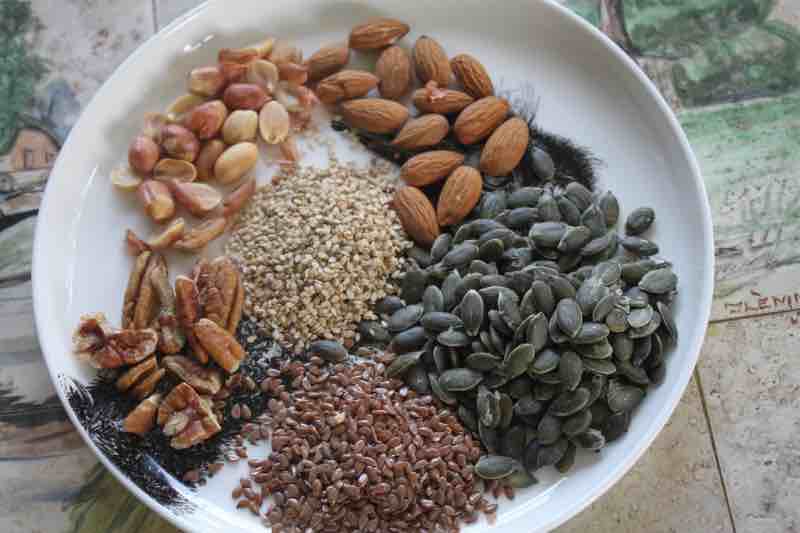 Nuts and seeds but not their extracted oils
Nuts and seeds but not their extracted oilsOlive oil it would appear is the one exception of extracted fats; perhaps because it is cold-pressed.
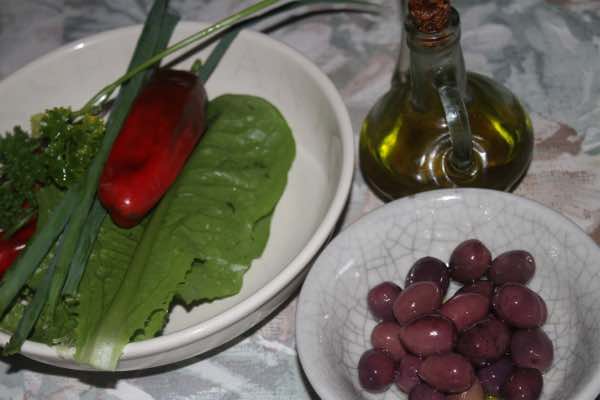 Olives and their oil on salads
Olives and their oil on saladsBread
Bread and its association with Fatty Pancreas is a difficult subject for us; we love our "staff of life" yet the solution is neither complex nor time-consuming.
Bread has been central to most cultures for thousands of years; but in the last decade or two it has become strongly associated with obesity, diabetes and pancreatic disease. Many diets recommend avoiding it completely.
We already know the reason. The modern loaf is made from refined flour, losing its intrinsic rich flavour; large amounts of sugar, salt and seed oils are added to restore taste and texture.
Foods for a healthy pancreas cannot include the modern industrial loaf. The not-difficult solution is a mill, bread machine and use of the ancient tradition of sourdough. It takes only five minutes daily to bake the best, healthiest slices in the world at a fraction of the cost of the grocery store alternative.
If you love bread and want to eat it despite being obese, bake your own.
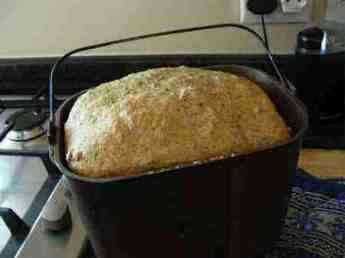 One slice is enough
One slice is enough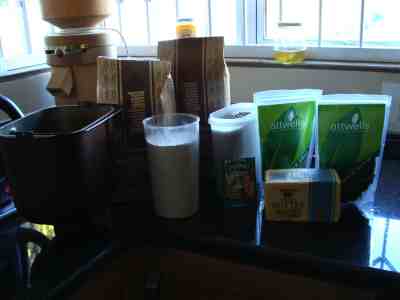
Add protein, butter and freshly-ground seeds for the perfect loaf; it's not in the slightest bit heavy.
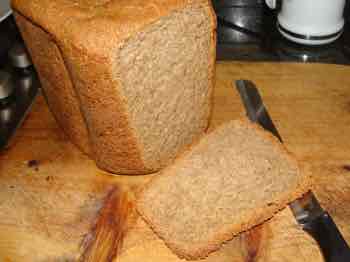
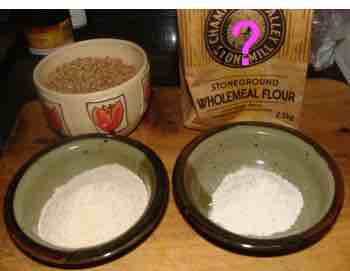
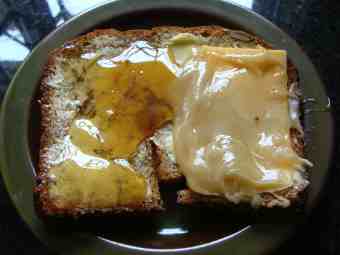
The queen was in her parlour; add cheese and butter to lower the GI. Then you can indulge in a teaspoon of raw honey.
We recommend raw honey for sweetening; surprisingly it has a low GI and even reduces the fasting blood glucose of diabetics[7]. But once the bottlers get hold of it, everything changes; it becomes highly glycaemic.
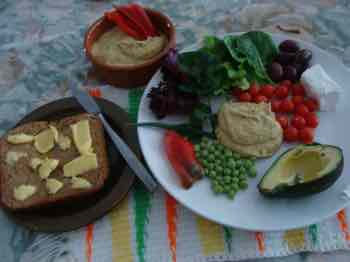 Hummus, avocado and peas; wholegrain bread
Hummus, avocado and peas; wholegrain breadBread, butter and a healthy salad make the perfect lunch; notice the many coloured foods.
- Obesity-related hypertension: a review of pathophysiology
- Global Incidence of Acute Pancreatitis Is Increasing Over Time
- Associations of Intrapancreatic Fat Deposition With Incident Diseases of the Exocrine and Endocrine Pancreas
- Adipocytes
- What Is Linoleic Acid?
- Heavy Meat Consumption Linked to Pancreatic Cancer
- Glycaemic and insulinaemic properties of some German honey varieties
When browsing use right click and "Open Link in New Tab" or you may get a bad gateway signal.
Newsletter
Our newsletter is entitled "create a cyan zone" at your home, preserving both yourself and Mother Earth for future generations; and the family too, of course. We promise not to spam you with daily emails promoting various products. You may get an occasional nudge to buy one of my books.
Here are the back issues.
- Lifestyle and ideal body weight
- What are ultra-processed foods?
- Investing in long-term health
- Diseases from plastic exposure
- Intensive lifestyle management for obesity has limited value
- A world largely devoid of Parkinson's Disease
- The impact of friendly bacteria in the tum on the prevention of cancer
- There's a hole in the bucket
- Everyone is talking about weight loss drugs
- Pull the sweet tooth
- If you suffer from heartburn plant a susu
- Refined maize meal and stunting
- Should agriculture and industry get priority for water and electricity?
- Nature is calling
- Mill your own flour
- Bake your own sourdough bread
- Microplastics from our water
- Alternative types of water storage
- Wear your clothes out
- Comfort foods
- Create a bee-friendly environment
- Go to bed slightly hungry
- Keep bees
- Blue zone folk are religious
- Reduce plastic waste
- Family is important
- What can go in compost?
- Grow broad beans for longevity
- Harvest and store sunshine
- Blue zone exercise
- Harvest and store your rainwater
- Create a cyan zone at your home
Did you find this page interesting? How about forwarding it to a friendly book or food junkie? Better still, a social media tick would help.
- Bernard Preston homepage
- Avocado
- Foods for a Healthy Pancreas
Address:
56 Groenekloof Rd,
Hilton, KZN
South Africa
Website:
https://www.bernard-preston.com